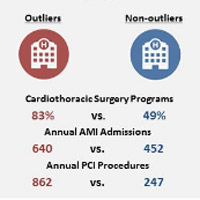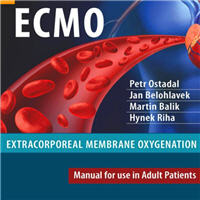Tag: mortality
Evaluating the Validity of Sepsis-3 Criteria in the Emergency Department
In this multicenter prospective cohort study involving 879 patients with suspected infection treated at the emergency department, the qSOFA was better at predicting in-hospital mortality with an area under the receiver operating... read more

The effect of day of the week on short- and long-term mortality for emergency general surgery
The effect of day of the week on outcome after surgery is the subject of debate. The aim was to determine whether day of the week of emergency general surgery alters short- and long-term mortality. Dr Mike Gillies and... read more

The Confusion Assessment Method for the ICU-7 Delirium Severity Scale
Delirium severity is independently associated with longer hospital stays, nursing home placement, and death in patients outside the ICU. Delirium severity in the ICU is not routinely measured because the available instruments... read more

Delays in Emergency Care and Mortality during Major U.S. Marathons
Large marathons frequently involve widespread road closures and infrastructure disruptions, which may create delays in emergency care for nonparticipants with acute medical conditions who live in proximity to marathon routes. Medicare... read more

The impact of emergency department crowding on early interventions and mortality in patients with severe sepsis
Critically ill patients require significant time and care coordination in the emergency department (ED). We hypothesized that ED crowding would delay time to intravenous fluids and antibiotics, decrease utilization of protocolized... read more

The Prevalence of Acute Critical Neurological Disease in Children
Neurologic insults are a significant pediatric international health issue. They are frequent and contribute substantial morbidity and mortality. These data suggest a need for an increased focus on acute critical neurologic... read more

Association between delirium superimposed on dementia and mortality in hospitalized older adults
In a prospective cohort study, Thiago Junqueira Avelino-Silva and colleagues examine the association of delirium superimposed on dementia on hospital mortality and 12-month mortality in hospitalized older adults. This was... read more

Relative Bradycardia in Patients With Septic Shock Requiring
Relative bradycardia in patients with septic shock is associated with lower mortality, even after adjustment for confounding. Our data support expanded investigation into whether inducing relative bradycardia will benefit... read more

Meta-analysis confirms EGDT for sepsis is unhelpful and wasteful (PRISM)
Three large, well-conducted randomized trials around the world (ProCESS, ARISE, and ProMISe) all agreed: use of early goal-directed therapy (EGDT) for sepsis does not improve mortality or any other important clinical outcome.... read more

Quantifying the Mortality Impact of Do-Not-Resuscitate Orders in the ICU
Do-not-resuscitate status is an independent risk factor for ICU mortality. This may reflect severity of illness not captured by other clinical factors, but the perceptions of the treating team related to do-not-resuscitate... read more

Vitamin D and outcomes in adult critically ill patients
In critically ill patients, vitamin D administration might be associated with a reduction in mortality without significant adverse events. A large multicenter randomized trial should conclusively confirm these findings. Seven... read more
Implementation of a Clinical Documentation Improvement Curriculum Improves Quality Metrics
Clinical documentation improvement/ICD-10 training in an academic surgery department is an effective method to improve documentation rates, increase the hospital estimated reimbursement based on more accurate CD, and provide... read more

The Emotional Toll of Treating Victims of Violence
Hospital leaders are implementing several techniques to address the lasting trauma of disaster emergencies. Hospital disaster drills often focus on transporting patients to the emergency department and moving them into the... read more

Ratio-based Transfusion and Non-trauma Patients
Researchers at Massachusetts General Hospital (MGH) urge caution in adopting ratio-based transfusion - a practice previously studied only in patients with severe traumatic injuries - in non-trauma patients. Their study published... read more

Presentations of adult septic patients in the prehospital setting as recorded by emergency medical services
The most common keywords related to septic patients’ symptom presentation were: abnormal/ suspected abnormal temperature (64.1.%), pain (38.4%), acute altered mental status (38.2%), weakness of the legs (35.1%), breathing... read more

Meta-Analysis of Therapeutic Hypothermia for Traumatic Brain Injury in Adult and Pediatric Patients
Therapeutic hypothermia is a likely beneficial treatment following TBI in adults, improving both neurologic outcomes and decreasing mortality rates. Our work suggests that the optimal management strategy to improve both morbidity... read more

National ICU Quality Indicators Revisited
The use of QI at a national level is a suitable method to focus on quality in healthcare. Independently of public access to the results, a local or national ICU network will have a lot to gain from engaging in the process... read more

Cerebral Microbleeds as Predictors of Mortality
Cerebral microbleeds (CMB) represent a common magnetic resonance imaging marker of cerebral small vessel disease, increasingly recognized as a subclinical marker of stroke and dementia risk. CMB detection may reflect the... read more

Multifaceted educational intervention shortened time to antibiotic administration in children with sepsis
A multifaceted educational intervention shortened time to antibiotic administration in children with severe sepsis and septic shock: ABISS Edusepsis pediatric study. The Surviving Sepsis Campaign (SSC) recommends the administration... read more

Stapled versus hand-sewn
Stapled versus hand-sewn: A prospective emergency surgery study. An American Association for the Surgery of Trauma multi-institutional study. Data from the trauma patient population suggests handsewn (HS) anastomoses are... read more

Quality of Care at Hospitals Identified as Outliers in Publicly Reported Mortality Statistics for Percutaneous Coronary Intervention
Public reporting of percutaneous coronary intervention (PCI) outcomes may create disincentives for physicians to provide care for critically ill patients, particularly at institutions with worse clinical outcomes. Large hospitals... read more

The status of intensive care medicine research and a future agenda for very old patients in the ICU
The "very old intensive care patients" (abbreviated to VOPs; greater than 80 years old) are probably the fastest expanding subgroup of all intensive care unit (ICU) patients. Up until recently most ICU physicians... read more










